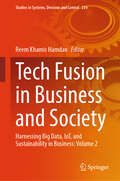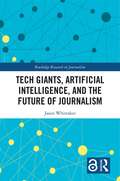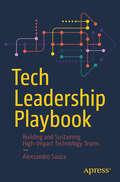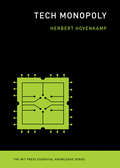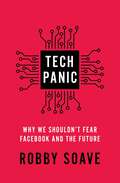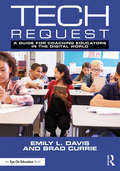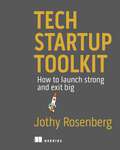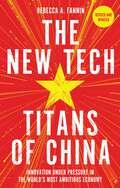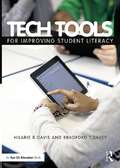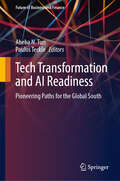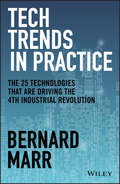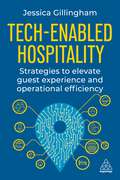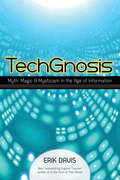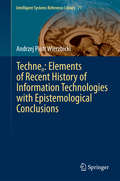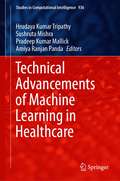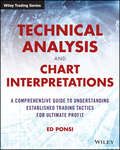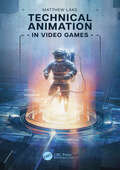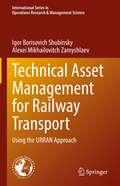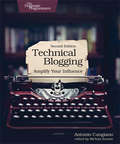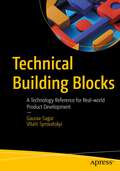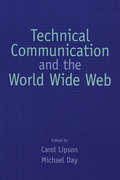- Table View
- List View
Tech Fusion in Business and Society: Harnessing Big Data, IoT, and Sustainability in Business: Volume 2 (Studies in Systems, Decision and Control #234)
by Reem Khamis HamdanThis book embarks on a deeper exploration of the intersection of technology and business with Volume 2 of 'Tech Fusion in Business and Society: Harnessing Big Data, IoT, and Sustainability.' This book, divided into two parts—'Diving into the Nexus: Artificial Intelligence, Technology, and Societal Impact' and 'Unveiling Synergies: Artificial Intelligence, Blockchain, Security, and Business Impact'—offers a comprehensive look at how these elements shape our world. This book delves into a rich tapestry of insights from leading experts, each chapter meticulously reviewed to ensure academic excellence and practical relevance. This book discovers how AI, blockchain, security, and more converge to drive innovation and influence the future of industries and societies.
Tech Giants, Artificial Intelligence, and the Future of Journalism (Routledge Research in Journalism)
by Jason Paul WhittakerThis book examines the impact of the "Big Five" technology companies – Apple, Alphabet/Google, Amazon, Facebook and Microsoft – on journalism and the media industries. It looks at the current role of algorithms and artificial intelligence in curating how we consume media and their increasing influence on the production of the news. Exploring the changes that the technology industry and automation have made in the past decade to the production, distribution and consumption of news globally, the book considers what happens to journalism once it is produced and enters the media ecosystems of the internet tech giants – and the impact of social media and AI on such things as fake news in the post-truth age. The audience for this book are students and researchers working in the field of digital media, and journalism studies or media studies more generally. It will also be useful to those who are looking for extended case studies of the role taken by tech giants such as Facebook and Google in the fake news scandal, or the role of Jeff Bezos in transforming The Washington Post. The Open Access version of this book, available at https://doi.org/10.4324/9781351013758, has been made available under a Creative Commons Attribution-Non Commercial-No Derivatives 4.0 license.
Tech Leadership Playbook: Building and Sustaining High-Impact Technology Teams
by Alexsandro SouzaImmerse yourself in this indispensable resource for leaders tasked with the challenge of building or managing effective software development teams. This book is based on practical wisdom, offering actionable guidance to foster high-performing teams that excel in their projects. Despite the pivotal role leadership plays in a team's success, there aren't many companies that employ structured, best-practice-driven leadership methods. The core of the book covers several critical areas essential for any tech leader's success: building high-performance teams, project management, code quality, software design and architecture, software development life cycle (SDLC), software quality insurance, observability, technology and business alignment The relevance of structured, principled leadership in tech has never been more important. Tech Leadership Playbook aims to equip leaders with the knowledge and tools necessary to navigate the challenges of evolving business successfully. What You Will Learn Establish industry-proven strategies for building and sustaining high-performance teams Empower teams through mission driven ownership and autonomy Reduce development cost through effective leadership Implement real Agile project management culture Gain a solid understanding of different software design architectures Leverage architectural principles to design robust and maintainable software systems Improve Code Quality with strategic SDLC practices Who This Book is For Senior engineers, tech leaders, engineering managers, CTO, CIO, project managers, agile coaches, and founders
Tech Monopoly (The MIT Press Essential Knowledge series)
by Herbert HovenkampA serious look at competition problems in tech markets and whether antitrust law can help address them.In recent years, the astronomical rise of tech giants like Amazon, Apple, Meta, and Microsoft has been criticized as anticompetitive, and many have wondered if antitrust law can help protect workers and consumers. In Tech Monopoly, Herbert Hovenkamp explores competition problems in a wide range of high-tech firms—from those that sell purely digital products, such as video streaming, search, software, or email services, to others that sell more traditional “tactile” products, such as hardware, clothing, groceries, or rides. He offers a realistic look at the powers and limitations of antitrust law in tech markets with an assessment that is as comprehensive as it is accessible.After a general introduction to antitrust law, Tech Monopoly considers how competitive harm should be assessed in these markets, as well as some features that make these markets unique, including “two-sided” structures. Then Hovenkamp looks at the role of large digital platforms, including Amazon, Alphabet, Apple, Meta, and Microsoft, and considers whether their size alone is an antitrust problem or if the concern should be limited to market power. Finally, the author addresses the very difficult problem of remedies. Should we “break up” big tech, and if so, how? What kind of breakup of these firms would make users or others better off? And if breakups are not the only possible antitrust fix, are there more effective and less disruptive alternatives?Offering simple explanations of the complex economics of digital platform markets, Tech Monopoly is an important read for anyone who wishes to understand how antitrust law works and whether it can help defend competition in the formidable era of big tech.
Tech Panic: Why We Shouldn't Fear Facebook and the Future
by Robby SoaveFrom award-winning journalist and author of the &“methodical, earnest, and insightful&” (The Guardian) Panic Attack, an examination of recent kneejerk calls to regulate Big Tech from both sides of the aisle.Not so long ago, we embraced social media as a life-changing opportunity to connect with friends and family all across the globe. Today, the pendulum of public opinion is swinging in the opposite direction as Facebook, Twitter, Google, YouTube, and similar sites are being accused of corrupting our democracy, spreading disinformation, and fanning the flames of hatred. We once marveled at the revolutionary convenience of ordering items online and having them show up on our doorsteps, sometimes overnight. Now we fret about Amazon outsourcing our jobs overseas, or building robots to do them for us. Here, with insightful analysis and in-depth research, Robby Soave explores some of the biggest issues animating both the right and the left: bias, censorship, disinformation, privacy, screen addiction, crime, and more. Far from polemical, Tech Panic is grounded in interviews with insiders at companies like Facebook and Twitter, as well as expert analysis by both tech boosters and skeptics—from Mark Zuckerberg to Josh Hawley. Readers will learn not just about the consequences of Big Tech, but also the consequences of altering the ecosystem that allowed tech to get big. Offering a fresh and crucial perspective on one of the biggest influences of the 21st century, Robby Soave seeks to stand athwart history and yell, Wait, are we sure we really want to do this?
Tech Request: A Guide for Coaching Educators in the Digital World
by Emily L. Davis Brad CurrieIn this much-needed book, experts Emily L. Davis and Brad Currie draw on their extensive experience in coaching and instructional technology and provide concrete, research-based strategies to help coaches in their day-to-day role. Whether you’re beginning a coaching initiative or looking for practical insights on coaching in a variety of settings, including in groups and one-to-one, you’ll find the resources you need to overcome challenges and grow your coaching skills. Topics include: The basics of tech coaching How to clarify on the expectations and objectives of your role Tips for recruiting teachers to work with you Guiding educators in planning and implementing meaningful technology integration How to plan and facilitate effective team coaching Strategies to gather and share data to communicate the impact of your coaching work How to stay ahead of the curve and keep learning for the future Every chapter includes practical tools, templates, and illustrative vignettes from the field to help you ensure the success of your technology coaching initiative. Join the conversation! Discuss the book and your coaching questions on Twitter with the hashtag #TechRequestEDU.
Tech Startup Toolkit: How to launch strong and exit big
by Jothy RosenbergEssential advice for anyone aspiring to start up a technology company, based on decades of business experience.In Tech Startup Toolkit, you&’ll discover the good, the bad, and the ugly of succeeding with a tech startup. Author Jothy Rosenberg reveals the insights he&’s learned from an entrepreneurial career that&’s seen both $100 million sales, dramatic failures, and everything in between. Tech Startup Toolkit gives you concrete, actionable advice on how to: • Succeed as a first-time CEO • Pitch and raise money from various types of investors • Develop a go-to-market strategy • Create a strong positive culture • Understand what makes a VC tick • Write an elevator pitch • Understand investment deal terms • Hone and align teams • Effectively downsize or wind down a company • Position a company to be acquired In Tech Startup Toolkit Jothy tells stories from his incredible career that will give guidance and inspiration to anyone who&’s ever thought of creating or running a company. Every personal story teaches a vital lesson for any would-be startup founder, ensuring you avoid the pitfalls that end less-prepared companies. Foreword by Vivjan Myrto. About the technology Why do eight out of ten tech startups fail? Is it inevitable? In Tech Startup Toolkit, nine-time tech startup founder Jothy Rosenberg tells you how to beat the odds. Part memoir and part survival guide, this book delivers battle-tested, unvarnished advice on capital, culture, boards, marketing, and management. About the book Tech Startup Toolkit covers everything a new founder needs to ensure a great idea can become a stable tech company that&’s ripe for acquisition. In 31 short anecdotes from Jothy&’s extensive experience, you&’ll learn how to pitch investors, develop a go-to-market strategy, and build the leadership skills that really matter for a great startup CEO. And since forewarned is forearmed, you&’ll also find strategies to handle challenges like funding loss, competition, and unpredictable crises like Covid-19 that break lesser startups. About the reader For prospective founders, early-stage teams, and anyone interested in tech entrepreneurship. About the author Jothy Rosenberg has been an incorrigible entrepreneur since 1988. Formerly the VP of Borland&’s developer division, Jothy has founded and run nine technology startups, two of which had $100 million exits. Table of Contents PART 1 1 Scratching the startup itch: How I became an incorrigible entrepreneur 2 What makes you think you are CEO material? 3 A venture-backed turnaround: A dangerous place to be 4 The founding team. Who&’s in and who&’s not? PART 2 5 Friends and family, angels, venture capital, or strategic? 6 Angels: Your bridge financing solution 7 The art of pitching to institutional investors 8 Investors aren&’t your friends 9 Understand the VC business model. Raise money faster 10 Seed: The first priced round 11 Term sheets: An institutional investor wants to invest in you 12 Due Diligence: An exam you must pass PART 3 13 Your business model. The beating heart of your business 14 Getting to a minimum viable product with lighthouse customers 15 Product-Market Fit. Making sure the dogs will eat your dog food 16 Go-to-Market: How to make your business viable and grow 17 A formal business plan in ten steps 18 Burn rate and runway—or where is the edge of that cliff? 19 Achieving cash-flow positive: A startup&’s Holy Grail 20 Your startup&’s valuation: Up, up, up (hopefully) PART 4 21 Hire slowly—and correctly 22 Beyond foosball: Crafting a positive culture that retains your team 23 Does a startup need both a
Tech Titans of China: How China's Tech Sector is Challenging the World by Innovating Faster, Working Harder & Going Global
by Rebecca FanninFeaturing detailed profiles of the Chinese tech companies making waves, the tech sectors that matter most in China's grab for super power status, and predictions for China's tech dominance in just 10 years.The rise of China's tech companies and intense competition from the sector is just beginning. This will present an ongoing management and strategy challenge for companies for many years to come. Tech Titans of China is the go-to-guide for companies (and those interested in competition from China) seeking to understand China's grand tech ambitions, who the players are and what their strategy is. Fannin, a leading expert on the Chinese tech sector, is an internationally-recognized journalist, author and speaker. Through her company, Silicon Dragon, Fannin hosts 12 live events annually for business leaders, venture capitalists, start-up founders, and others impacted by or interested in the Chinese tech industry.
Tech Titans of China: How China's Tech Sector is challenging the world by innovating faster, working harder, and going global
by Rebecca FanninThe rise of China's tech companies and intense competition from the sector is just beginning. This will present an ongoing management and strategy challenge for companies for many years to come. Tech Titans of China is the go-to-guide for companies (and those interested in competition from China) seeking to understand China's grand tech ambitions, who the players are and what their strategy is. Fannin, an expert on China, is an internationally-recognized journalist, author and speaker. She hosts 12 live events annually for business leaders, venture capitalists, start-up founders, and others impacted by or interested in cashing in on the Chinese tech industry. In this illuminating book, she provides readers with the ammunition they need to prepare and compete. Featuring detailed profiles of the Chinese tech companies making waves, the tech sectors that matter most in China's grab for super power status, and predictions for China's tech dominance in just 10 years.
Tech Tools for Improving Student Literacy
by Hilarie B. Davis Bradford T. DaveyTechnology isn’t just fun to use in the classroom, it can also make real improvements in students’ literacy development. In this book, authors Hilarie Davis and Bradford Davey show you how and why to use tech tools to help enhance the teaching of reading, writing, speaking, listening, and viewing. These tools can be used in English/Language Arts and across the subject areas to promote literacy throughout your school. Special Features: Practical classroom examples from a variety of content areas Connections to specific Common Core State Standards "Using the Technology" boxes with step-by-step guidance on using a tool Screenshots that show how the tools work Strategies to help you use the tools effectively with students
Tech Transformation and AI Readiness: Pioneering Paths for the Global South (Future of Business and Finance)
by Abeba N. Turi Paulos TeckleThis book presents the trends of tech transformation and AI- readiness of emerging economies across regulatory, social, economic, and infrastructure layers. With the increased pace of urbanization, digital transformation, and proliferation of the algorithm economy, data and infrastructural readiness play vital roles in economic growth and development. By taking evidence (theoretical and empirical evidence) from selected emerging economies, this work intends to shed light on the developments and tech-readiness of these economies, focusing on AI solutions with the analysis of tech infrastructure and data readiness. Besides, it provides an in-depth presentation of empirical evidence on tech transformation and best practices with the constructs for AI tech readiness of emerging economies at national and institutional levels. The studies presented in this edited book will help to bridge the gap in the scanty literature about data, infrastructure, and AI readiness of emerging economies by looking into the challenges and opportunities. Major topics covered include AI solutions in Organizational value creation, green economy, sustainability, positive AI risk monitoring as a tech opportunity, assessment, mitigation, (renewable) energy generation, management and utilization, education, security, healthcare system, and more.
Tech Trends in Practice: The 25 Technologies that are Driving the 4th Industrial Revolution
by Bernard MarrDiscover how 25 powerful technology trends are transforming 21st century businesses How will the latest technologies transform your business? Future Tech Trends in Practice will give you the knowledge of today’s most important technology trends, and how to take full advantage of them to grow your business. The book presents25 real-world technology trends along with their potential contributions to organisational success. You’ll learn how to integrate existing advancements and plan for those that are on the way. In this book, best-selling author, strategic business advisor, and respected futurist Bernard Marr explains the role of technology in providing innovative businesses solutions for companies of varying sizes and across different industries. He covers wide-ranging trends and provides an overview of how companies are using these new and emerging technologies in practice. You, too, can prepare your company for the potential and power of trending technology by examining these and other areas of innovation described in Future Tech Trends in Practice: Artificial intelligence, including machine and deep learning The Internet of Things and the rise of smart devices Self-driving cars and autonomous drones 3D printing and additive manufacturing Blockchain technology Genomics and gene editing Augmented, virtual and mixed reality When you understand the technology trends that are driving success, now and into the future, you’ll be better positioned to address and solve problems within your organisation.
Tech in Translation
by Carollyne HutterIn Morocco, deaf children were at a disadvantage when it comes to their education. When Dr. Abdelhadi Soudi built a computer program that can translate sign language, it improved the way Morocco teaches their deaf children by leaps and bounds!
Tech-Enabled Hospitality: Strategies to Elevate Guest Experience and Operational Efficiency
by Jessica GillinghamWhile the hotel and short term rental sectors are growing, there is a technology divide between operators using technology strategically to run better operations and those that are not. Hospitality professionals need to understand their businesses' pain points to better invest in technology solutions and transform their businesses to be more profitable, and in some cases, more personal. Tech-enabled Hospitality looks at how the intersection of technology and personalized service can redefine the future of hospitality, including for large chains and small and medium-sized enterprises (SMEs) in the lodging sector. With its focus on practical applications of technology for enhancing both operational efficiency and guest experiences, this book is a valuable resource for those looking to modernize their hospitality business without losing the essence of personal touch. Through real-world examples and in-depth expert interviews from brands such as Stripe, SiteMinder and Rocco Forte, this book explores hospitality functions such as hotel management, operations, revenue management, sustainability, IoT, access control, guest communications, payment processing, guest experience, virtual concierge and AI tools. This book will help hospitality professionals better understand the hows and whys of implementing technology to run everyday aspects of a hospitality business while still leaving room, if desired, to provide a uniquely human experience that underpins true 'hospitality'.
TechGnosis
by Erik Davis Eugene ThackerHow does our fascination with technology intersect with the religious imagination? In TechGnosis--a cult classic now updated and reissued with a new afterword--Erik Davis argues that while the realms of the digital and the spiritual may seem worlds apart, esoteric and religious impulses have in fact always permeated (and sometimes inspired) technological communication. Davis uncovers startling connections between such seemingly disparate topics as electricity and alchemy; online roleplaying games and religious and occult practices; virtual reality and gnostic mythology; programming languages and Kabbalah. The final chapters address the apocalyptic dreams that haunt technology, providing vital historical context as well as new ways to think about a future defined by the mutant intermingling of mind and machine, nightmare and fantasy.From the Trade Paperback edition.ology; programming languages and channeled texts. The final chapters address both apocalyptic and utopian dreams of the future of technology, providing historical context as well as new models for how to think and feel our way through an amazing, confusing, and disturbing time. This new edition features a foreword by Eugene Thacker as well as a new afterword reflecting on surveillance; the current tech bubble; the growth of superheroes, horror, and other "uncanny cultures" online; the growing backlash against technology; and the need to revitalize the cosmic imagination.ContentsIntroduction: crossed wires I imagining technologies II the alchemical fire III the gnostic infonaut IV techgnosis, american-style V the spiritual cyborg VI a most enchanting machine VII cyberspace: the virtual craft VIII the alien call IX datapocalypse X third mind from the sun XI the path is a network Afterword: beyond the boomFrom the Trade Paperback edition.
Technen: Elements of Recent History of Information Technologies with Epistemological Conclusions
by Andrzej Piotr WierzbickiThe book expresses the conviction that the art of creating tools - Greek techne - changes its character together with the change of civilization epochs and co-determines such changes. This does not mean that tools typical for a civilization epoch determine it completely, but they change our way of perceiving and interpreting the world. There might have been many such epochs in the history of human civilization (much more than the three waves of agricultural, industrial and information civilization). This is expressed by the title Technen of the book, where n denotes a subsequent civilization epoch. During last fifty years we observed a decomposition of the old episteme (understood as a way of creating and interpreting knowledge characteristic for a given civilization epoch) of modernism, which was an episteme typical for industrial civilization. Today, the world is differently understood by the representatives of three different cultural spheres: of strict and natural sciences; of human and social sciences (especially by their part inclined towards postmodernism) and technical sciences that have a different episteme than even that of strict and natural sciences. Thus, we observe today not two cultures, but three different episteme. The book consists of four parts. First contains basic epistemological observations, second is devoted to selected elements of recent history of information technologies, third contains more detailed epistemological and general discussions, fourth specifies conclusions. The book is written from the cognitive perspective of technical sciences, with a full awareness - and discussion - of its differences from the cognitive perspective of strict sciences or human and social sciences. The main thesis of the book is that informational revolution will probably lead to a formation of a new episteme. The book includes discussions of many issues related to such general perspective, such as what is technology proper; what is intuition from a perspective of technology and of evolutionary naturalism; what are the reasons for and how large are the delays between a fundamental invention and its broad social utilization; what is the fundamental logical error (using paradoxes that are not real, only apparent) of the tradition of sceptical philosophy; what are rational foundations and examples of emergence of order out of chaos; whether civilization development based on two positive feedbacks between science, technology and the market might lead inevitably to a self-destruction of human civilization; etc.
Technical Advancements of Machine Learning in Healthcare (Studies in Computational Intelligence #936)
by Pradeep Kumar Mallick Amiya Ranjan Panda Hrudaya Kumar Tripathy Sushruta MishraThis book focuses on various advanced technologies which integrate with machine learning to assist one of the most leading industries, healthcare. It presents recent research works based on machine learning approaches supported by medical and information communication technologies with the use of data and image analysis. The book presents insight about techniques which broadly deals in delivery of quality, accurate and affordable healthcare solutions by predictive, proactive and preventative methods. The book also explores the possible use of machine learning in enterprises, such as enhanced medical imaging/diagnostics, understanding medical data, drug discovery and development, robotic surgery and automation, radiation treatments, creating electronic smart records and outbreak prediction.
Technical Analysis and Chart Interpretations: A Comprehensive Guide to Understanding Established Trading Tactics for Ultimate Profit (Wiley Trading)
by Ed PonsiEd Ponsi's straightforward guide to understanding technical analysis Technical Analysis and Chart Interpretations delivers simple explanations and easy-to-understand techniques that demystify the technical analysis process. In his usual straightforward style, bestselling author Ed Ponsi guides you through the twists and turns to show you what really matters when it comes to making money. Whether you trade stocks, currencies, or commodities, you'll develop invaluable skills as you master difficult concepts and the tools of the trade. Technical analysis translates to any form of trading, and this book delivers clear, jargon-free guidance toward interpreting the various charts you'll see in the field. Technical analysis can be confusing. Volatility, cycles, Elliot waves, Fibonacci, trends—it's easy to get lost, and most of the available literature is incomprehensible to all but the experts. This book is different—it's technical analysis for the rest of us. You'll see through the language to understand the underlying concepts, and how to apply them correctly. Learn what true technical analysis entails Discover the tools that simplify accurate analysis Master the tactics and strategies used by the pros Develop a valuable trading skill that transcends markets Simply recognizing the vocabulary isn't nearly enough, and a passing acquaintance with the topic is guaranteed to do more harm than good. When technical analysis methods are used incorrectly, they are ineffective at best, and actively destructive to your bottom line at worst. Technical Analysis and Chart Interpretations cuts through the confusion to give you a firm understanding and the skills to apply it correctly.
Technical Animation in Video Games
by Matthew LakeThis book provides a comprehensive overview of video game technical animation, covering the next generation pipelines that industry developers utilise to create their games. It covers the technical animation workflow from start to finish, looking at both software and hardware, as well as the industry standard processes that all technical animators need to know. Written to be an accessible technical animation resource, this book combines easy-to-understand principles with educational use cases on how to combine the principles and tools taught within. Example test scripts, animation files, and rig assets are provided as tangible examples that can be modified and taken apart to deepen your understanding. It covers the end-to-end pipeline of technical animation, from the very first steps of placing joints in Autodesk’s Maya to breathe life into your static characters, through tools and automation development, all the way to Unreal Engine 5 integration and optimisation. Additional resources are available on the book’s GitHub repository. From this resource, you will find example files for Maya and Python scripts that will help with your own work and demonstrations featured throughout this book. This book is essential reading for early-career game technical animators as well as those studying game animation courses. It will also appeal to technical animators working in the film industry.
Technical Asset Management for Railway Transport: Using the URRAN Approach (International Series in Operations Research & Management Science #322)
by Igor Borisovich Shubinsky Alexei Mikhailovitch ZamyshlaevThis book introduces readers to the key provisions of the URRAN-based technical asset management system - a methodology for managing resources and risks by analyzing and ensuring the required levels of reliability and safety in Russia’s railway transport facilities. It describes the architecture of the URRAN information system’s unified corporate platform (UCP URRAN) and its subsystems for infrastructure facilities and rolling stock complexes. It also highlights the UCP URRAN’s prospects for development, especially in the application of artificial intelligence to predict dangerous events in railway transport operation. The book is chiefly intended for specialists engaged in practical work on the technical maintenance of railway transport facilities. It can also be used as a reference guide for students and researchers at railway universities or professionals who are dealing with problems in technical asset management in other industries.
Technical Blogging: Amplify Your Influence
by Antonio CangianoSuccessful technical blogging is not easy but it's also not magic. Use these techniques to attract and keep an audience of loyal, regular readers. Leverage this popularity to reach your goals and amplify your influence in your field. Get more more users for your startup or open source project, or simply find an outlet to share your expertise. This book is your blueprint, with step-by-step instructions that leave no stone unturned. Plan, create, maintain, and promote a successful blog that will have remarkable effects on your career or business. Successful people often get recognition by teaching what they know. Blogging is a reliable path to do that, while gaining influence in the process. The problem is getting it right. Far too often professionals start a blog with big hopes, only to quickly give up because they don't get speedy results. This book will spare you that fate, by outlining a careful plan of action. A plan that will bring amazing benefits to your career, new job possibilities, as well as publishing, speaking, and consulting opportunities. And if you are blogging for business, you'll attract new customers, partners, and outstanding employees. Understand what blogging is and how it can improve your professional (and personal) life. Devise a plan for your new or existing blog. Create remarkable content that ranks well in Google and is shared by readers. Beat procrastination by employing proven time-management techniques that make you an efficient and effective blogger. Promote your blog by mastering on-page and off-page SEO, as well as social media promotion, without compromising your ethics. Analyze your traffic to understand your audience and measure growth. Build a community around your blog and make the best of your newfound popularity, by maximizing its benefits for your career, business, or simply for extra income. Create and maintain a successful technical blog that will amplify your impact, influence, and reach by following Antonio's step-by-step plan.
Technical Blogging: Turn Your Expertise into a Remarkable Online Presence
by Antonio CangianoTechnical Blogging is the first book to specifically teach programmers, technical people, and technically-oriented entrepreneurs how to become successful bloggers. There is no magic to successful blogging; with this book you'll learn the techniques to attract and keep a large audience of loyal, regular readers and leverage this popularity to achieve your goals.Become more influential and earn extra money by blogging. Whether you want to create a popular technical blog from scratch or take your blog to the next level, this book shows you how.Technical blogging expert Antonio Cangiano shares his extensive expertise with you, sparing no details and laying out a complete step by step road map to help you plan, create, market, monetize, and grow your own popular blog.Antonio will guide you through all the choices you have to make in setting up a successful blog, teach you the key things you need to know to write blog posts that get read, and give you the tools to produce content regularlyYou'll learn how to promote your blog, understand traffic statistics, and build a community. And once you've built it, you'll learn how to benefit from it: advance your career, make money from your blog, use it to promote your products or company, and take advantage of your blog to the fullest. And when your blog takes off, Antonio will show you how to avoid the pitfalls of success. Technical Blogging is the only guide you'll need to create and maintain a successful technical blog.
Technical Building Blocks: A Technology Reference for Real-world Product Development
by Gaurav Sagar Vitalii SyrovatskyiThis book offers comprehensive coverage of the various technologies and techniques used to build technical products. You will learn how technical product development is collaboratively done across multiple technical teams, primarily those in software engineering, data engineering, and AI/ML engineering. You will also be introduced to the technologies these teams use to develop features and products. Many roles in the organization work alongside these technical product development teams and act as liaisons between them, the stakeholders, the customers, and the leadership team. The people in these roles must understand technical aspects ranging from system design to artificial intelligence, and be able to engage in technical discussions with the engineering teams to determine the pros, cons, and risks associated with the development of a technology product or feature. Technical Building Blocks will help you master these technical skills. The book has just the right level of technical details to neither overwhelm with unnecessary technical depth, nor be superficial. From concepts to code snippets, authors Gaurav Sagar and Vitalii Syrovatskyi cover it all to give you an understanding of the engineer's mind and their work. Special emphasis on figures and charts will help you grasp complex ideas more quickly. After reading this book, you’ll be able to effectively communicate with engineering teams, provide valuable inputs in the system design review meetings of upcoming features and products, synthesize and simplify technical updates for cross-functional teams and stakeholders, and pass those dreaded technical interviews at your dream companies. What You Will Learn Intrinsic details of the teams and techniques used for product development Concepts of cloud computing and its deployment modelsSystem design fundamentals required to architect features and products Evolution of data pipelines and data storage solutions to support big dataML and deep learning algorithms to build intelligence into productsSecuring products through identity and access management using cryptographyRole and working of blockchains, smart contracts, NFTs, and dApps in Web3 Who This Book is For Professionals in roles who work with software engineering teams and want to build their technical muscle, such as product managers, program managers, business analysts, project managers and product owners. Also useful for those preparing to crack the technical interview for these roles.
Technical Communication and the World Wide Web
by Michael Day Carol LipsonOver the past decade, the World Wide Web has dramatically changed the face of technical communication, but the teaching of writing has thus far altered very little to accommodate this rapidly changing context. Technical Communication and the World Wide Web offers substantial and broadly applicable strategies for teaching global communication issues affecting writing for the World Wide Web.Editors Carol Lipson and Michael Day have brought together an exceptional group of experienced and well-known teacher-scholars to develop this unique volume addressing technical communication education. The chapters here focus specifically on curriculum issues and the teaching of technical writing for the World Wide Web, contributing a blend of theory and practice in proposing changes in curriculum and pedagogy. Contributors offer classroom examples that teachers at all levels of experience can adapt for their own classes. The volume provides comprehensive coverage of the technical communication curriculum, from the two-year level to the graduate level; from service courses to degree programs.This volume is an important and indispensable resource for technical writing educators, and it will serve as an essential reference for curriculum and pedagogy development in technical communication programs.
Technical Debt in Practice: How to Find It and Fix It
by Rick Kazman Neil Ernst Julien DelangeThe practical implications of technical debt for the entire software lifecycle; with examples and case studies.Technical debt in software is incurred when developers take shortcuts and make ill-advised technical decisions in the initial phases of a project, only to be confronted with the need for costly and labor-intensive workarounds later. This book offers advice on how to avoid technical debt, how to locate its sources, and how to remove it. It focuses on the practical implications of technical debt for the entire software life cycle, with examples and case studies from companies that range from Boeing to Twitter. Technical debt is normal; it is part of most iterative development processes. But if debt is ignored, over time it may become unmanageably complex, requiring developers to spend all of their effort fixing bugs, with no time to add new features--and after all, new features are what customers really value. The authors explain how to monitor technical debt, how to measure it, and how and when to pay it down. Broadening the conventional definition of technical debt, they cover requirements debt, implementation debt, testing debt, architecture debt, documentation debt, deployment debt, and social debt. They intersperse technical discussions with "Voice of the Practitioner" sidebars that detail real-world experiences with a variety of technical debt issues.
